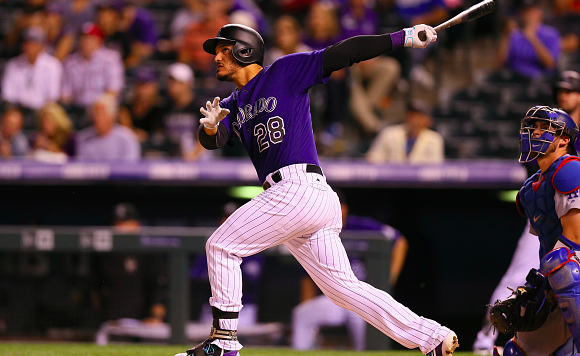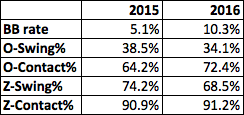Colorado Rockies third baseman Nolan Arenado is one of baseball’s best all-around players. Despite that, he doesn’t get nearly as much airtime as some other superstars.
Why is that? Well, Denver isn’t exactly a huge media market when compared to New York, Chicago or Los Angeles. Playing for a team that can’t get over .500 doesn’t help, either (Mike Trout has been able to buck that trend a little bit, but he’s a special case).
Arenado’s fielding ability has always been there – he’s won a Gold Glove each year since debuting for Colorado in 2013 – and he’s had a good bat, but he went into another stratosphere during the 2015 season. As a 24-year-old, he slashed .287/.323/.575 while leading the National League in both home runs (42) and RBI (130) over 616 at-bats.
With about a month left in 2016, his numbers are sitting just about where they were a year ago. Through 506 at-bats, he’s slashing a healthy .294/.365/.583 while leading the National League in homers (36) and RBI (115).
More or less, 2016 looks a heck of a lot like 2015 did. He went to the All-Star game for the second consecutive year; he’ll also be in the running for another Gold Glove as well as a Silver Slugger. What’s interesting is digging a little deeper into his numbers and seeing that he arrived at very similar results in a slightly different way.
Similarities
He’s still a reverse splits guy
For all you fantasy baseball players out there, you know the importance of looking at how a hitter performs against left- and right-handed pitchers. With star players, these matchups don’t matter as much because they hit everyone consistently.
Arenado is in that camp, but he’s enjoyed more success against right-handers despite being a right-handed hitter. Here’s what his splits looked like in 2015:
And in 2016:
He’s certainly closed the gap when it comes to his slugging percentage, but that’s still a pretty significant difference.
July has been his most troublesome month
It doesn’t matter how good a hitter is—the MLB regular season is so long that everyone is prone to experiencing some peaks and valleys along the way. The difference between bad, good and great players is the length of those peaks and valleys. For Arenado, the month of July has been his worst month in each of the last two seasons.
Check out this side-by-side comparison using OPS:
It’s pretty clear to see how much more he struggled in July last season, and one can only imagine his overall numbers if he wasn’t limited to just one homer and 10 RBI. Arenado has experienced a similar dip in production this past July, as it’s been the only month he didn’t produce a slugging percentage over .500 (although, .475 ain’t too shabby).
Hard-hit rate is nearly identical
Look—someone who produces as much as Arenado does is going to hit the ball hard consistently. After posting a 28.7 percent hard-hit rate in his rookie year, he’s never been below 33 percent. He did take a noticeable step forward in this department last year, which has remained steady throughout 2016 (via FanGraphs):
Differences
Increased plate discipline
This is not groundbreaking news—we’ve talked about it a number of times with other young hitters. As a player matures, so does their plate discipline. Through his first four years in the big leagues, Arenado boasted a walk-rate that landed somewhere around five percent.
That’s doubled in his age-25 season, and it’s because he’s being more selective at the plate (via FanGraphs).
We see young players harness their talent by being more selective at the plate all the time. It’s common, but it also doesn’t happen to everyone.
His home/road splits are getting more drastic
If your home games are played at Coors Field, there’s going to be a discrepancy between your home and road splits. That’s just the way life is, and it also doesn’t matter how good you are, people are always going to mention it.
Arenado isn’t immune to that judgment, either. He’s obviously a better hitter when the Rockies are home than when they are on the road, but his power numbers weren’t totally different in 2015:
In fact, he hit more homers on the road (22) than at home (20) last year. Outside of hitting three more doubles at Coors Field, the biggest difference was the four triples he collected in front of the home crowd.
The gap in his slugging percentage has increased rather significantly so far this season:
He’s hit the majority of his homers at Coors Field (21 at home, 15 on the road), but it’s important to note he’s also hit 21 of his 30 doubles at home. That’s a likely result of hitting more fly balls this season thanks to an increased launch angle, as Anthony Rescan of SB Nation’s Beyond the Boxscore points out.
Instead of slowing down in the second half, he’s getting better
We already touched upon how July has been a problem month for the right-handed slugger each of the last two years. In 2015, that July swoon was so bad that he couldn’t quite make up for it in August and September:
This year, the July slump wasn’t nearly as bad, but slashing .356/.433/.702 in 104 at-bats during August has led to an overall increase in his production since the All-Star break:
There’s still a lot of baseball to be played before closing the book on the regular season, but it’s clear to see that Arenado improved on what was a career year in 2015. Some of his production stayed relatively the same, but there have been enough slight differences and adjustments that’s helped him get to yet another level.
The most exciting part for the Rockies is this could only just be the beginning since he’s about to enter his physical prime. So, that means there’s possibly even more growth to come in 2017 and beyond.
Unless otherwise noted, all statistics courtesy of Baseball-Reference.
Thanks for reading! If you’d like to jumpstart your sportswriting career and aren’t sure how, check out my eBook. Don’t forget to follow me on Twitter so we can chat about baseball: @mmusico8.





























